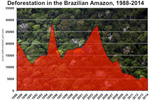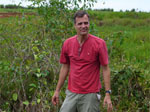Continuing deforestation in the Amazon rainforest could undermine agricultural productivity in the region by reducing rainfall and boosting temperatures, warns a new study published in the journal Environmental Research Letters.
The research is based on a model that simulates the impact of forest loss and global climate change on local rainfall and temperature. The model then forecasts the effect on the productivity of soybean farms and cattle ranches, the two dominant forms of land use after deforestation in the Brazilian Amazon. The researchers find that climate change and deforestation will have a significant impact on agricultural yields in the region, reducing pasture productivity by 30-34 percent and soybean yields 24-28 percent, depending on the degree of forest loss. The study also projects a steep decline in the amount of carbon stored in vegetation, potentially worsening climate change through increased emissions.
“Large-scale agriculture expansion in Amazonia may introduce climate feedbacks that would reduce precipitation, leading agriculture expansion in Amazonia to become self-defeating: the results of this study suggest that the more agriculture expands, the less productive it becomes,” the authors, led by Leydimere Oliveira of the Federal University of Viçosa, write. “This would be a no-win situation, in which we all lose.”

Forest and agricultural land in the Brazilian Amazon in 2009. Photo by Rhett A. Butler
The findings suggest a limit to which agricultural expansion at the expense of forest should be permitted. However other research has indicated that limiting deforestation, at least in the Brazilian Amazon, may not limit agricultural production due to the current low-value use of large swathes of land. Intensification, even without the use of agrochemicals and industrial feedlots, could dramatically increase the volume of agricultural products that come out of the region. For example, some research has suggested that shifting low-intensity cattle pasture to oil palm plantations could boost carbon storage and local incomes, while maintaining more forest function relative to poorly managed cattle pasture. In some areas it may ultimately make economic sense to allow forests to regenerate, while focusing cattle production on smaller areas of land.
Study lead author Oliveira says that the study demonstrates the economic importance of maintaining forest cover in the Amazon.
“We were initially interested in quantifying the environmental services provided by the Amazon and their replacement by agricultural output,” Oliveira said in a statement. “We expected to see some kind of compensation or off put, but it was a surprise to us that high levels of deforestation could be a no-win scenario – the loss of environmental services provided by the deforestation may not be offset by an increase in agriculture production.”
“There may be a limit for expansion of agriculture in Amazonia. Below this limit, there are not important economic consequences of this expansion. Beyond this limit, the feedbacks that we demonstrated start to introduce significant losses in the agriculture production.”

Cattle in the Brazilian Amazon in 2009. Photo by Rhett A. Butler
CITATION: Leydimere J C Oliveira, Marcos H Costa, Britaldo S Soares-Filho and Michael T Coe (2013). Large-scale expansion of agriculture in Amazonia may be a no-win scenario. Environmental Research Letters 8 024021.
Related articles
Brazil’s success in reducing deforestation will be hard to replicate
(04/23/2013) The sharp reduction in deforestation in the Brazilian state of Mato Grosso since the mid-2000s will be difficult to replicate in other tropical countries where commodity production is a major driver in forest loss, argues a new study published in a special issue of the journal Philosophical Transactions of the Royal Society B.
Brazil’s deforestation at record low from 2011-2012

(11/27/2012) Deforestation in the Brazilian Amazon fell to the lowest rate since annual record-keeping began in 1988 according to provisional data released Tuesday by Brazil’s National Space Research Agency (INPE). 1,798 square miles (4,656 square kilometers) of Amazon forest was chopped down during the 12 months ending July 31, 2012, 27 percent less than the year earlier period.
As Amazon deforestation falls, food production rises
(01/09/2012) A sharp drop in deforestation has been accompanied by an increase in food production in the Brazilian state of Mato Grosso, reports a new study published in the journal Proceedings of the National Academy of Science. The research argues that policy interventions, combined with pressure from environmental groups, have encouraged agricultural expansion in already-deforested areas, rather than driving new forest clearing.
Ending deforestation could boost Brazilian agriculture

(06/26/2010) Ending Amazon deforestation could boost the fortunes of the Brazilian agricultural sector by $145-306 billion, estimates a new analysis issued by Avoided Deforestation Partners, a group pushing for U.S. climate legislation that includes a strong role for forest conservation. The analysis, which follows on the heels of a report that forecast large gains for U.S. farmers from progress in gradually stopping overseas deforestation by 2030, estimates that existing Brazilian farmers could see around $100 billion from higher commodity prices and improved access to markets. Meanwhile landholders in the Brazilian Amazon—including ranchers and farmers—could see $50-202 billion from carbon payments for forest protection.
How to save the Amazon rainforest
(01/04/2009) Environmentalists have long voiced concern over the vanishing Amazon rainforest, but they haven’t been particularly effective at slowing forest loss. In fact, despite the hundreds of millions of dollars in donor funds that have flowed into the region since 2000 and the establishment of more than 100 million hectares of protected areas since 2002, average annual deforestation rates have increased since the 1990s, peaking at 73,785 square kilometers (28,488 square miles) of forest loss between 2002 and 2004. With land prices fast appreciating, cattle ranching and industrial soy farms expanding, and billions of dollars’ worth of new infrastructure projects in the works, development pressure on the Amazon is expected to accelerate. Given these trends, it is apparent that conservation efforts alone will not determine the fate of the Amazon or other rainforests. Some argue that market measures, which value forests for the ecosystem services they provide as well as reward developers for environmental performance, will be the key to saving the Amazon from large-scale destruction. In the end it may be the very markets currently driving deforestation that save forests.
Globalization could save the Amazon rainforest

(06/03/2007) The Amazon basin is home to the world’s largest rainforest, an ecosystem that supports perhaps 30 percent of the world’s terrestrial species, stores vast amounts of carbon, and exerts considerable influence on global weather patterns and climate. Few would dispute that it is one of the planet’s most important landscapes. Despite its scale, the Amazon is also one of the fastest changing ecosystems, largely as a result of human activities, including deforestation, forest fires, and, increasingly, climate change. Few people understand these impacts better than Dr. Daniel Nepstad, one of the world’s foremost experts on the Amazon rainforest. Now head of the Woods Hole Research Center’s Amazon program in Belem, Brazil, Nepstad has spent more than 23 years in the Amazon, studying subjects ranging from forest fires and forest management policy to sustainable development. Nepstad says the Amazon is presently at a point unlike any he’s ever seen, one where there are unparalleled risks and opportunities. While he’s hopeful about some of the trends, he knows the Amazon faces difficult and immediate challenges.
Globalization could save the Amazon rainforest

(06/03/2007) The Amazon basin is home to the world’s largest rainforest, an ecosystem that supports perhaps 30 percent of the world’s terrestrial species, stores vast amounts of carbon, and exerts considerable influence on global weather patterns and climate. Few would dispute that it is one of the planet’s most important landscapes. Despite its scale, the Amazon is also one of the fastest changing ecosystems, largely as a result of human activities, including deforestation, forest fires, and, increasingly, climate change. Few people understand these impacts better than Dr. Daniel Nepstad, one of the world’s foremost experts on the Amazon rainforest. Now head of the Woods Hole Research Center’s Amazon program in Belem, Brazil, Nepstad has spent more than 23 years in the Amazon, studying subjects ranging from forest fires and forest management policy to sustainable development. Nepstad says the Amazon is presently at a point unlike any he’s ever seen, one where there are unparalleled risks and opportunities. While he’s hopeful about some of the trends, he knows the Amazon faces difficult and immediate challenges.